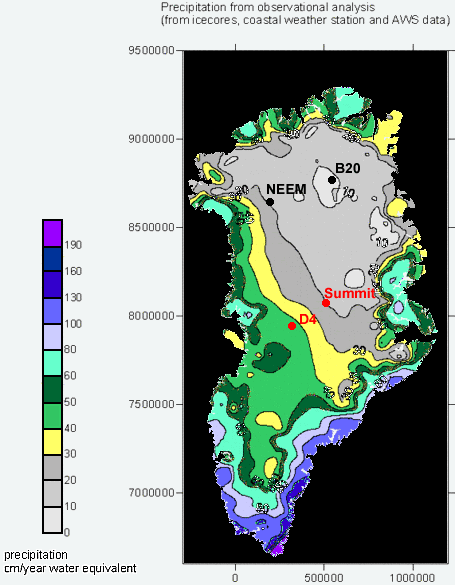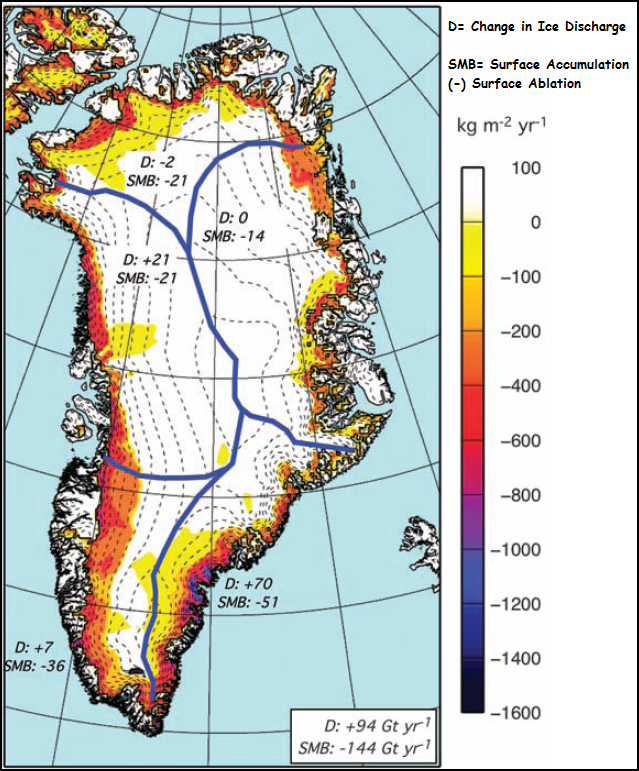- Joined
- Jan 3, 2014
- Messages
- 16,501
- Reaction score
- 3,829
- Location
- Sheffield
- Gender
- Male
- Political Leaning
- Other
Oh, a science site. That sounds so authoritative. :mrgreen:
The evidence from NASA and other scientists is empirical evidence, which showed losses around 270gt/yr a few years ago, now down slightly to 220 or so. Most of it is satellite data; they also use ice cores, water flows and more.
Doing some math on an envelope is not "empirical evidence." So are you referring to something else, or do you just not know what the phrase "empirical evidence" means?
So your utter failure to recognize that expertise is required to understand earth science and climatology is supposed to change my mind? Lol
Amusingly, you were looking right at the answer... just in black and white. The color map below of the precipitation map makes it much more obvious. The heaviest precipitation in Greenland falls on coastal areas, and flows off immediately. Far less falls on the ice sheet itself.
View attachment 67220872
I might add that if you're looking for "40 Mississippis," you might want to look at the coastline. Go ahead, spend a few minutes on Google Earth. It's quite fascinating.
View attachment 67220876
View attachment 67220877
The image below is one of the areas that gets the most rainfall:
View attachment 67220878
I suspect that resolves much of the mystery here.
Again, much of the water that accumulates on the ice sheet itself is calved off. About half flows off in ice streams, some on top of the glaciers, but many flow into moulins, which typically drain into the ocean underneath the glaciers.
One thing I've found, from going through various articles on this topic is that this is an incredibly difficult discipline. It involves a variety of methods of analysis, ranging from computer models to precipitation measurements to observation of water flows to cloud cover (fyi, a 1% reduction in cloud cover increases ice losses by 27gt/yr) to a variety of satellite measurements to ice core samples and more. Even my discussion above is a gross oversimplification of the ice mass budget for Iceland. Looking into this has merely reinforced my respect for the scientists who are working on these projects.
In other words, you aren't going to get realistic figures by a bit of math scribbled on a napkin.
I post this again;
http://www.igsoc.org:8080/journal/37..._pg140-148.pdf
Journal of Glaciology j;;. 144 a b x:. y;;. d c Fig. 1. Comparison of various accumulation maps for the Greenland ice sheet; a. Bader (1961); b. Benson (1962); c. Mock (1967); d. present work.
You can see the detailed map of where and how much accumulation of snow happens on Greenland. It is not all falling on the coast. The interior gets lots.
The size of the river flows coming out of the glaciers you show is not a Mississippi's worth. Not even all of them all together are that much. The Mississippi is about 800m wide. And deep. And mighty. You need 40 to break even. 47 to get the loss rate you want there to be.


